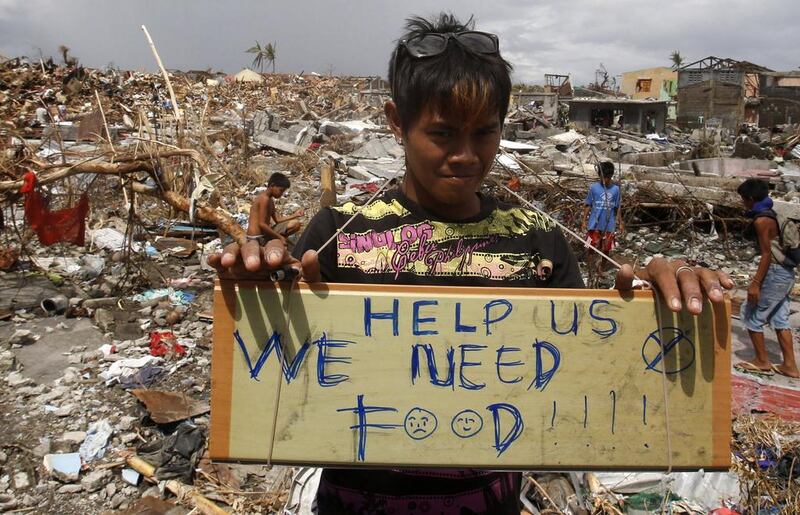MANILA // Medical teams, aid workers and soldiers crammed onto flights to Tacloban city in central Philippines yesterday as survivors told of desperation over the trickle of supplies to the area six days after Typhoon Haiyan caused massive destruction.
Philippine Air Force planes were making round trips from neighbouring Cebu to the area that bore the brunt of Haiyan, a super typhoon that the government said killed at least 2,357 people. The planes ferried in aid workers and supplies, and brought out survivors, mostly the elderly and injured.
Tens of thousands of people are living in the open or in damaged buildings, exposed to rain and wind, Valerie Amos, the United Nations humanitarian chief, said. “Medical facilities for those who were injured, food, clean water and basic sanitation are urgently required,” she said at a briefing in Manila. “The situation is dismal. People are extremely vulnerable and desperate for help.”
Field hospitals are being set up in Tacloban. Two teams operating water purifiers will be sent to the city, Luigi D’Angelo, leader of the European Civil Protection Team, told reporters in Cebu.
As aid agencies called for donations and countries sent supplies and teams, relief efforts were still being hampered by roads washed away or blocked by debris, a lack of vehicles to transport aid from Tacloban airport, and gridlock at Cebu airstrips. The desperation among survivors in Tacloban led President Benigno Aquino to declare a state of calamity and plead with locals to be patient.
The country’s disaster agency said 3,853 people were injured in the typhoon, which destroyed nearly 240,000 homes and caused US$94.2 million (Dh346m) in infrastructure and farm output damage. About 11.5 million people were affected, with 545,000 displaced, the Ms Amos said.
Survivors arriving by plane in Cebu from Tacloban said they were not warned of the seriousness of the typhoon. “Even our mayor didn’t understand what a storm surge is,” said Michael Angelo Tan, 29, who saw 20 people dead in the city’s convention centre. “They were trapped there by the water, there was a stampede,” he said.
“The government was not prepared,” said Rina Pontejos, a 29-year-old cashier. “Village guards at least should have given warnings and asked people to evacuate. What were they there for?” Tacloban has a population of about 221,000.
Melanie Valdestamon, a 29-year-old nurse, said her house was hit by knee-deep water even though it was some distance from the shore. “We tied big water bottles to a mattress to build a raft for our baby so he would survive.”
The Red Cross is sending 1,500 more body bags to Tacloban, the capital of Leyte province, to add to the 500 it already dispatched, Philippine Red Cross Chairman Richard Gordon told reporters in Cebu. “We’re picking the bodies up, managing the dead,” Mr Gordon said.
About 2,000 soldiers and policemen are in the Eastern Visayas region following looting incidents in Leyte, Office of Civil Defense Administrator Eduardo del Rosario said in Manila. Eastern Visayas covers Leyte and Samar islands.
Survivors who arrived in Cebu from Guiuan in East Samar province said some residents ignored advice to evacuate.
Elaine Pading, 42, scheduled a live band performance in her karaoke restaurant on the night of the storm, thinking the winds would not be that strong. The roof of her restaurant was ripped off and windows smashed. “We thought we wouldn’t live until the next morning,” she said.
Jason Gagala, 30, and his wife hid their 10-month old son in a cabinet in their home during the storm. “The people of Guiuan did not prepare,” he said. “We are seeking for understanding in this situation” Communications Secretary Herminio Coloma said in a briefing in Manila. “The severity and the magnitude of this disaster is unprecedented and unparalleled in previous experience. In this context, we have to understand that the demands were also extraordinary.”
The UN has admitted that it could have done more to help Filipinos.
“I do feel that we have let people down,” said Ms Amos.
Yesterday world and regional powers were deploying forces to assist those affected by the disaster.
The USS George Washington, with 5,000 sailors aboard, headed a flotilla of vessels bearing badly needed equipment, supplies and expertise for the thousands left homeless and hungry.
Japan is planning to send about 1,000 troops to the Philippines in what officials say could become the military’s biggest relief effort ever and China will donate $1.64 million in relief materials, the official Xinhua News Agency said.
The relief goods will include blankets and tents, the agency said in a story that also mentioned that hundreds of tons of aid are “standing idly” because they cannot be delivered to the victims of the storm.
The Philippines military has transported more than 6,000 people from Tacloban and Ormoc in Leyte and from Guiuan in Eastern Samar, Lieutenant Jim Alagao said. “Most of them are typhoon victims, some are rescuers,” he said.
The death toll would make Haiyan one of the deadliest storms in the country’s history. In late 2012 Typhoon Bopha killed 1,067, while the death toll from Thelma reached 5,080 in late 1991.
Bloomberg News with additional reporting by Associated Press





